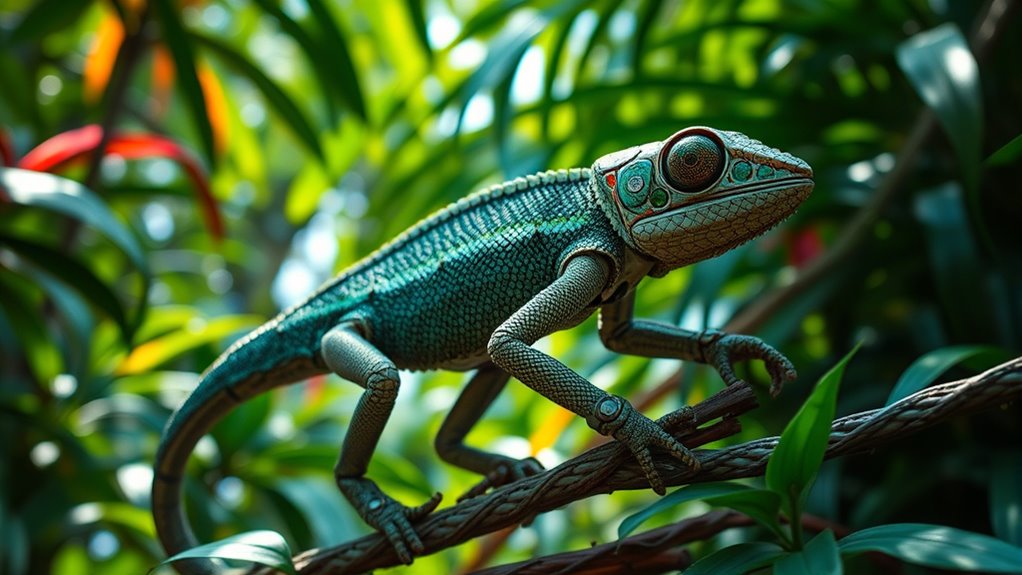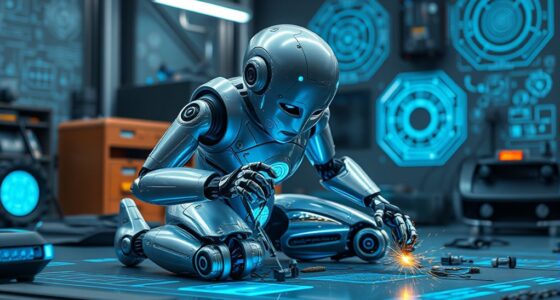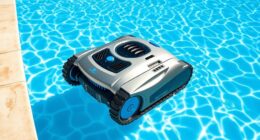Bio-inspired robots learn from nature’s smartest, most efficient designs to create adaptable machines that can survive in diverse environments. By mimicking animals like birds, fish, and insects, these robots gain agility, resilience, and sensory perception. They use advanced materials, sensors, and control systems for better performance. If you want to discover how these innovations are shaping future technology and solving real-world challenges, keep exploring — there’s much more to uncover.
Key Takeaways
- Bio-inspired robots mimic biological systems to enhance adaptability, efficiency, and resilience across diverse environments.
- They leverage advanced materials and sensors to replicate nature’s solutions for survival and environmental challenges.
- These robots serve in applications like environmental monitoring, disaster response, and sustainable agriculture.
- Innovations include collective swarm behaviors and self-healing materials to improve durability and cooperative survival.
- Ethical and sustainable development focuses on minimizing environmental impact while maximizing functional resilience.
Exploring the Essence of Bio-Inspired Robotics

Bio-inspired robotics draws inspiration directly from nature’s complex and efficient designs to create machines that can adapt, perform, and survive in diverse environments. You leverage biomimicry to emulate nature’s solutions to engineering challenges, resulting in robots with intricate mechanisms that mirror biological systems.
These robots are designed to adapt seamlessly to terrestrial, aerial, or aquatic settings, making them versatile tools for various applications. They prioritize efficiency and sustainability by integrating advanced materials, sensors, actuators, and control algorithms.
Diverse Types of Robots Mimicking Nature
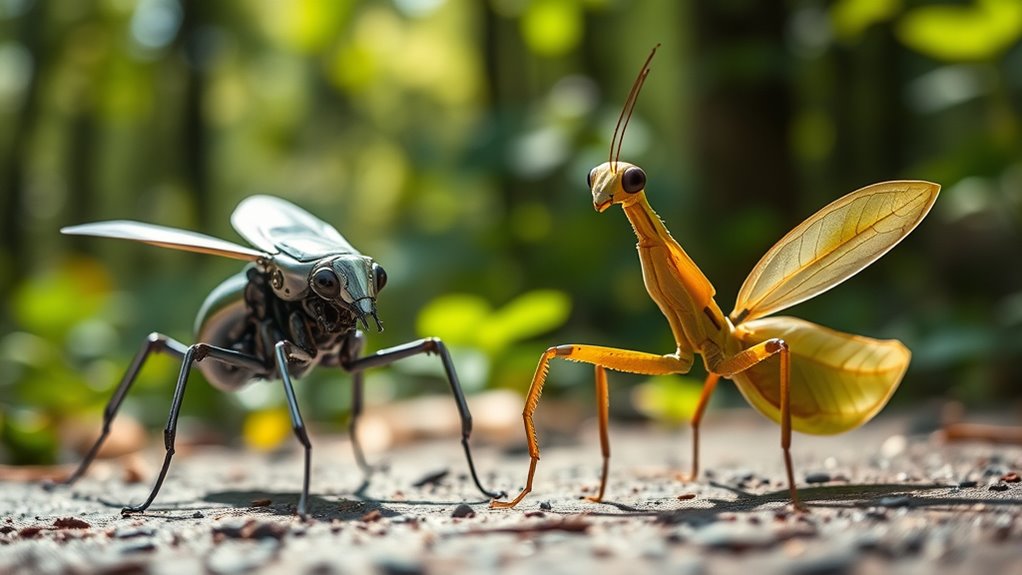
Building on the idea of nature-inspired design, researchers have developed a variety of robots that mimic specific biological systems to perform specialized tasks.
Researchers develop robots mimicking biological systems for specialized tasks.
In aerial robotics, you’ll find bionic birds like the Bionic Bird, which replicate bird flight mechanics, and RoboBee, using artificial muscles to hover and fly like bees. Festo’s butterfly-inspired robots demonstrate agility and maneuverability. These innovations often utilize high-performance materials that enable precise movements and durability.
In marine environments, robots like MIRO mimic fish movements, while whale-inspired designs enhance aquatic efficiency. Octopus arm robots offer flexible underwater manipulation, and bio-inspired propulsion systems improve underwater mobility.
On land, legged robots such as Rhex, kangaroo-inspired jumpers, and spider-like robots navigate complex terrains. Amphibious robots combine flying and swimming abilities.
Manipulation robots, inspired by octopus arms and butterfly vision, enhance perception and dexterity.
Additionally, robotic control systems are crucial in coordinating complex movements and ensuring stability across diverse environments.
Cutting-Edge Technologies Powering Bio-Inspired Designs
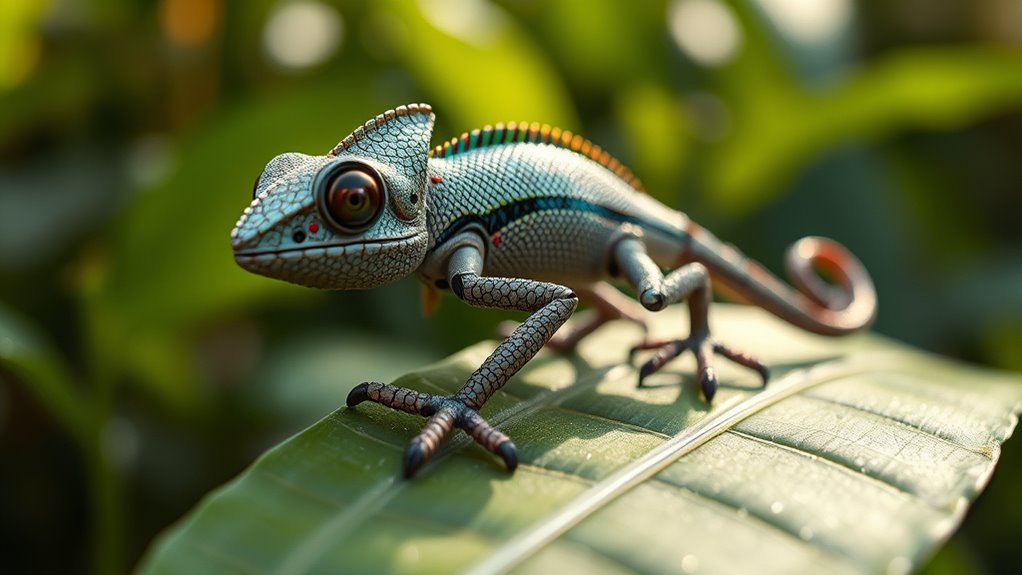
Advances in actuation, materials, sensors, and control systems are driving the development of highly sophisticated bio-inspired robots. Magnetic actuation allows precise, wireless control, mimicking natural muscle responses, while soft robotics uses fluidic elastomer actuators for smooth, organic motions like octopus tentacles.
Electroactive polymers create artificial muscles that contract and expand, boosting flexibility, and shape memory alloys enable robots to change shape or stiffness dynamically, similar to biological adaptivity. Material innovation is crucial for developing more adaptable and resilient robotic systems that can better emulate biological functions.
Hybrid systems combining pneumatic, hydraulic, and electric components enhance movement complexity and efficiency. Additionally, sensor technologies allow these robots to perceive their environment more accurately, leading to improved interaction and responsiveness. Incorporating biomimetic materials further enhances the ability of robots to replicate complex biological functions with increased durability. The integration of adaptive control systems also plays a vital role in achieving seamless, real-time adjustments to unpredictable environments, much like living organisms.
The use of preppy dog names as inspiration for designing robotic personalities could foster more relatable interactions between humans and bio-inspired robots. Nanomaterials and tunable hydrogels further improve strength, mobility, and interaction, powering the next generation of highly capable, nature-inspired robots.
Real-World Uses and Advantages of Nature-Inspired Robots

Nature-inspired robots are transforming various industries by offering practical solutions rooted in the efficiency and adaptability of biological systems. In agriculture, insect-inspired microrobots pollinate crops and monitor fields, boosting productivity.
Environmental agencies use fish-like robots to track water quality, providing real-time data. After natural disasters, insect-inspired robots navigate debris to assess damage quickly and safely. Understanding the importance of data collection enhances the effectiveness of these systems in disaster response. Incorporating nutrition-rich ingredients like chia seeds into the design of bio-inspired robots can improve their energy efficiency and sustainability. Additionally, integrating biomimicry principles into their design can further optimize performance and environmental compatibility.
For security, stealthy drones and robots mimic animals to conduct covert surveillance. Marine explorers utilize fish-shaped robots for underwater mapping and research. Additionally, the development of vetted materials ensures that these robots are safe and sustainable for long-term use.
These robots excel in complex environments due to their adaptability, consume less energy, and perform diverse tasks with precision. Their flexible, bio-inspired designs improve safety and sustainability, offering cost-effective solutions that open new markets and create jobs across multiple sectors. Additionally, advances in wave and wind energy technology inspire new ways to power these bio-inspired systems sustainably.
Overcoming Challenges in Replicating Biological Systems

Replicating the intricate behaviors and control mechanisms of biological systems presents a significant challenge in bio-inspired robotics. The complexity of biological interactions demands advancements in materials, actuators, sensors, and algorithms to mimic nature’s sophistication. Merchant services technologies can inspire more secure and efficient payment processing methods that could be integrated into robotic systems for seamless transactions. Fabrication techniques must handle multiple materials and delicate features at high resolution, but low throughput and poor scalability hinder production. Simplifying structures can ease manufacturing without losing essential functions. Achieving robustness and adaptability is equally tough; biological systems seamlessly adjust to uncertain environments through advanced sensing and control. Soft robotics struggle with complex motion control and feedback, though integrating resilient algorithms and responsive materials helps. Additionally, ongoing research into biomimetic materials offers promising avenues for creating more adaptable and durable robotic components. Exploring biologically inspired designs can further enhance the resilience and versatility of robotic systems. Incorporating adaptive control mechanisms can improve how robots respond to unpredictable environments. Furthermore, integrating AI-powered sensing can significantly enhance robots’ ability to interpret complex stimuli and adapt accordingly. Balancing technological integration, scalability, and ethical considerations remains crucial in overcoming these hurdles and advancing bio-inspired robotics.
Paving the Way for Future Innovations in Bio-Inspired Robotics

The field of bio-inspired robotics is rapidly evolving, with new designs that closely integrate biological principles into mechanical systems. You’ll see robots with sophisticated structures that mimic nature, making them more versatile and efficient.
Multifunctionality allows them to perform various tasks, just like animals and humans, expanding their application range. Material innovations, such as biomaterials and self-healing polymers, improve durability and performance. Incorporating sustainable materials in their construction can further enhance eco-friendliness and reduce environmental impact. Additionally, research into biomimetic materials can lead to even more resilient and adaptable robotic systems. These advancements are supported by ongoing developments in renewable energy solutions, which can power robotic systems sustainably, reducing reliance on non-renewable sources. Exploring energy efficiency in design is crucial for maximizing operational lifespan and minimizing environmental footprint.
Swarm robotics, inspired by insect colonies, enhances coordination for complex missions. Environmental adaptability guarantees robots can operate across diverse settings—from land and water to space.
Frequently Asked Questions
How Do Bio-Inspired Robots Adapt to Unpredictable Environments?
You might wonder how bio-inspired robots handle unpredictable environments. They adapt by using multisensory inputs to perceive their surroundings accurately, much like animals do. Incorporating learning algorithms helps them adjust their actions based on real-time feedback.
Their agile locomotion allows navigation through complex terrains, and advanced control systems enable quick decision-making. These features work together, making them more resilient and versatile in diverse, unpredictable settings.
What Ethical Issues Arise From Creating Autonomous Bio-Inspired Robots?
You need to contemplate the ethical issues when creating autonomous bio-inspired robots. These include concerns about their impact on ecosystems, data privacy, and potential harm to living beings.
You also face questions about moral status, responsibility for accidents, and ensuring safe human interaction.
Designing these robots responsibly requires clear guidelines, transparency, and ongoing oversight to prevent misuse, protect privacy, and maintain ecological balance.
How Scalable Are Bio-Inspired Designs for Large or Small Applications?
You might find that bio-inspired designs are quite adaptable across different sizes, but scaling isn’t always straightforward. For large applications, swarm robotics and hierarchical networks offer promising solutions, yet they require careful resource management.
Small-scale robots benefit from innovative actuation and sensory systems, but face unique physical constraints. Overall, with ongoing technological advances and modular approaches, these designs can be effectively tailored to both big and tiny tasks.
Can Bio-Inspired Robots Develop Self-Healing Capabilities?
You ask if bio-inspired robots can develop self-healing capabilities. The answer is yes. Researchers are making great progress with bio-hybrid materials that mimic natural healing processes, allowing robots to repair damage quickly and efficiently.
These advancements enable robots to maintain functionality even after injury, especially in hazardous environments. With ongoing innovation, self-healing features will become more reliable, enhancing the safety, durability, and adaptability of bio-inspired robots in various applications.
What Are the Cost Implications of Deploying Bio-Inspired Robots Widely?
You might find it surprising, but deploying bio-inspired robots widely comes with significant cost implications. The high initial R&D, specialized skills, and advanced materials drive up development costs.
Yet, their long-term operation offers savings through energy efficiency, durability, and modularity. By adopting scalable, low-cost manufacturing and overcoming regulatory hurdles, you can reduce costs, making these robots more accessible.
Still, balancing initial investments with long-term benefits remains a key challenge.
Conclusion
By embracing nature’s brilliance, you open innovative solutions that enhance survival and adaptability. Did you know that bio-inspired robots can outperform traditional designs, with some achieving up to 50% more efficiency? As you explore this field, you’ll see how learning from nature’s strategies leads to smarter, more resilient robots. Keep pushing boundaries, because the future of robotics lies in mimicking life itself—improving how we live, work, and adapt to challenges.

